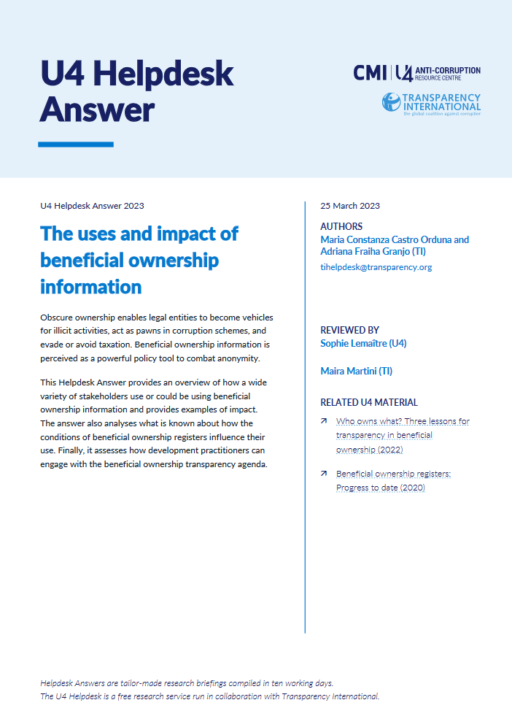
This Anti-Corruption Helpdesk brief was produced in response to a query from a U4 Partner Agency. The U4 Helpdesk is operated by Transparency International in collaboration with the U4 Anti-Corruption Resource Centre based at the Chr. Michelsen Institute.
Query
Please provide an overview of the stakeholders using beneficial ownership information, how the information is used and the impacts/outcomes it has had. What areas require improvements to use beneficial ownership information more effectively? How can development practitioners engage in the work?
Summary
Obscure ownership enables legal entities to become vehicles for illicit activities, act as pawns in corruption schemes, and evade or avoid taxation. Beneficial ownership information is perceived as a powerful policy tool to combat anonymity.
This Helpdesk Answer provides an overview of how a wide variety of stakeholders use or could be using beneficial ownership information and provides examples of impact. The answer also analyses what is known about how the conditions of beneficial ownership registers influence their use. Finally, it assesses how development practitioners can engage with the beneficial ownership transparency agenda.
Main points
- Beneficial ownership registers, primarily established within AML frameworks, can be useful to competent authorities and obliged entities and to members of the public to effectively prevent, detect, and counter financial crime.
- Examples of uses beyond the AML sector have shown the untapped potential of the use of beneficial ownership information by a wider range of stakeholders advancing broader policy objectives, including public procurement, tax justice and sanction implementation.
- The type of access, available functionalities, and the quality of information in beneficial ownership registers influence their use and can lead to a proactive use of this data.
Contents
- Introduction
- Uses and impact of beneficial ownership information among key stakeholders
- The use and impact of beneficial ownership information for AML
- The use and impact of beneficial ownership information beyond AML
- Lessons learned from the use of beneficial ownership so far
- Accessibility of beneficial ownership information
- Functionality of beneficial ownership registers
- Quality and adequacy of beneficial ownership information
- Beneficial ownership and development practitioners
- References
Authors
Maria Constanza Castro Orduna and Adriana Fraiha Granjo (TI), [email protected]
Reviewers
Sophie Lemaître (U4) and Maira Martini (TI)
Date
27/03/2023
Tags
 Download PDF
Download PDF
